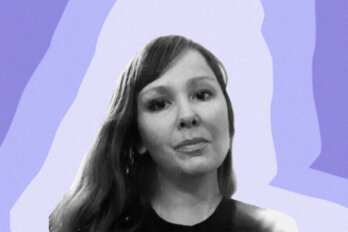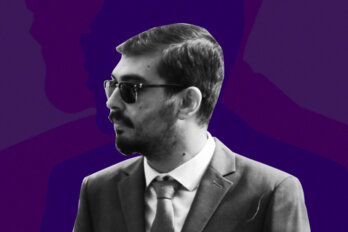In the late spring of 2015, my brother-in-law paid a visit to my sister’s grave, in a lush meadow cemetery amid the Gatineau Hills of southern Quebec. My sister had been dead, at this point, for seven years, and the couple had been separated for twelve. Doug sat in the grass among planted geraniums for half an hour or so, musing about the rise and fall of their marriage. He told Katharine, or her grave, that he was sorry for the part he had played in the dissolution. Then, plucking up and tossing a handful of grass, desultory, he began his two-and-a-half-hour motorcycle journey back to Montreal.
“The landscape is open there, with a big wide sky, but it was overcast and had started to rain—just barely, but it made me a bit nervous,” Doug later told me. Even fit riders in their fifties experience the occasional lapse in confidence. “It wasn’t until I was maybe halfway home that I felt her presence.”
“The sense wasn’t physical at first,” he went on, “just this really nice, strong awareness of her. And then I had the distinct sensation of her arms around me and her leaning in close against my back. It was tactile and fantastic. I felt warm. I was completely calm and happy, smiling from ear to ear. That hardly ever happens to me.” His nervousness about the rain ebbed, and it occurred to him that Katharine was there to keep him safe on behalf of their two sons. She—her presence, her spirit—rode behind him for twenty minutes or so. “What I know is that it did not feel at all like a product of my imagination,” he said. “It felt external to me. It felt real.”
He wasn’t prepared to name what the experience pointed to: that he had been visited by my sister’s ghost. Like other secular North Americans, he is aware that we must uphold a certain paradigm and say “this cannot be.” After all, Doug considers himself a rationalist: the son of an engineer, himself an amateur astronomer. Nevertheless, the sensed presence mattered deeply to him. “It was,” he said, “a remarkable, indelible experience.”
Sigmund Freud was the first to articulate the concept of “wishful psychosis” in grief, a notion of temporary madness featuring wilfully conjured visions of the dead. A person who’s lost someone might see the face of their beloved, hear their voice, notice the smell of their pipe or perfume, or simply be struck by a feeling of their presence. Such ghostly apparitions were diagnosed as fanciful yearnings by Freud—warning signs of some lingering dependency. In his 1917 essay “Mourning and Melancholia,” he urged his patients toward recovery by severing bonds with the dead: move on and let go, lest sorrow bedevil and sink you. For decades, this was one of the counselling profession’s central models for grief recovery: a sort of tacit agreement played out between therapist and patient that what the latter sensed, no matter how comforting it may be or how real it may seem, dwelled in their head and would best be forgotten. When the physician W. Dewi Rees uncovered the prevalence rate of these hallucinations in a 1972 study of Welsh widows and widowers—about 50 percent—he also found that three-quarters of them had never spoken of the experience before being asked in his survey. Unsurprisingly, these people didn’t wish to be pathologized. They also didn’t want to move on.
In 1970, English author Sylvia Townsend Warner, a frequent contributor of short stories to The New Yorker, had an unexpected visit from her dead lover, Valentine Ackland, lost the previous year to breast cancer. Roused one night at three, Warner found, as she later wrote in her diary, that Ackland had followed her to bed. “Not remembered,” she clarified, “not evoked, not a sense of presence. Actual.” In the dark quiet of their British cottage, this “actual” Ackland, solid yet ephemeral, engaged in a reuniting embrace. Then she was gone. “I held her again,” Warner noted with deep satisfaction. “It was. It is.”
Ought anyone to have argued with her? Death and its accompanying grief are often shrouded by awkward silences, but the unwavering prevalence of these apparitions, whether viewed as grief hallucinations or as ghosts, lays bare a metaphysical crisis at the heart of our common model of mourning: for there to be efficacy in recovery, these experiences must be respected as real. As counselling psychologist Edith Maria Steffen notes in her book, Continuing Bonds in Bereavement, there is a “controversial reality status” at play that can erode the trusting relationship between therapist and bereaved person if not handled with care and nuance. The same can be said for family and friends. The question is not whether these apparitions are real, it’s why the first impulse of many is to stifle these stories and dismiss the experiences as impossible.
Familial and fraternal hauntings have long been central to the stories we tell, from Enkidu’s ghost in The Epic of Gilgamesh to Odysseus conferring with his slain brother-in-arms Achilles to Banquo’s discarnate presence in Macbeth to Wuthering Heights’s sorrowful Catherine. More recently, there’s erratic detective John River, who confers with his newly dead partner, Stevie, in the television series River.
In the nineteenth century, such fictive imaginings were often based on real losses as infectious disease swept through families. Harriet Beecher Stowe, for example, watched her toddler, Charley, die in a Cincinnati cholera outbreak during the summer of 1849. She began to read, as she described it, “of visions, of heavenly voices, of mysterious sympathies and transmissions of knowledge from heart to heart without the intervention of the senses, or what Quakers call being ‘baptized into the spirit’ of those who are distant.” Her husband, theologian Calvin Stowe, regularly perceived discarnates of one kind or another, according to English scholar Harold K. Bush, and mused in a letter to a friend, “Is it absurd to suppose that some peculiarity in the nervous system . . . may bring some men more than others into an almost abnormal contact with the spirit-World?”
In Uncle Tom’s Cabin, Tom has a perception of his friend Eva’s postmortem presence. As Beecher Stowe would later write, the dead “still may move about in our homes, shedding an atmosphere of purity and peace. . . . We are compassed about by a cloud of witnesses, whose hearts throb in sympathy with every effort and struggle, and who thrill with joy at every success.”
The first scientific survey that examined visions of the dead was conducted in the 1880s by some founding members of London’s Society for Psychical Research (SPR). Investigations into the unconscious mind were coming into vogue, examining mysteries like hypnosis and dreams; meanwhile, the proliferation of cameras and telegraphs, with their figures frozen in time and disembodied voices, were upending what people thought possible. The SPR scholars, some of them scientists, were fascinated by the question of how we know what we know. One of these members was Alfred Russel Wallace, co-inventor of the theory of evolution, who disagreed with Charles Darwin that natural selection explained consciousness. Another was Samuel Clemens, also known as Mark Twain, whose interest stemmed from 1858, when he’d had a vivid dream of his brother lying in a coffin. Not long afterward, that same brother died in a steamboat explosion on the Mississippi River.
SPR member and Cambridge scholar Frederic Myers was intrigued by the many stories of ghosts and synchronistic dreams as well as by folklores concerning visions and doppelgängers. Many cultures across western Europe had their own versions. Scotland’s “second sight” was mirrored by Ireland’s taidhbhse (pronounced tiyv-shuh): “To see the double at night implies the death of the person seen,” as explained by folklorist Lewis Spence. The Bretons called such portents intersignes, while elsewhere in France one spoke of revenants. These were popular beliefs, but they certainly had never been examined through the scientific method.
According to Deborah Blum’s 2006 book, Ghost Hunters, Myers, along with his colleagues Edward Gurney and Frank Podmore, undertook a randomized survey of the British public, putting out the question, “Have you—when in good health, free from anxiety and completely awake—had a vivid impression of seeing or being touched by a human being, or of hearing a voice or sound which suggested a human presence, when no one was there?” They weren’t sure what they would find given the vagueness of the prompt. But, when the accounts came in, one surprise was the number of reports concerning ghostly apparitions of people known to the writer rather than spirits of the haunted-house variety.
A characteristic account in their collection, which, in 1886, they published in two volumes titled Phantasms of the Living, was provided by one Timothy Cooper, who described being busy at work: “I was going down into the cellar to fetch butter for a customer, and as I was on the top step, I saw my father standing at the bottom of the cellar steps in his shirt and night-cap, and he seemed to walk into the cellar. I went down and fetched the butter and looked for my father, who was nowhere to be seen.” At the time, his father was dying 400 kilometres away.
In 1889, wishing to expand upon this work, the SPR recruited 410 volunteers to each ask at least twenty-five British adults, from various walks of life, a similar question about spectral impressions. Approximately 13 percent replied that they had experienced the phenomenon. The men were able to identify and investigate eighty cases with corroborated evidence—through written documentation or witnesses—that the sensory experience corresponded with a death of someone known to them. Nine other countries participated in this Census of Hallucinations, including the United States (organized by “father of American psychology” William James), France (overseen by psychologist Leon Marillier), Germany, Russia, and Brazil, gathering 17,000 responses in total. Each survey reflected the results of the others, suggesting that between 7 and 19 percent of people experience sensory hallucinations at some point in their lives.
It was some of the first social science data collected on this phenomenon. It was also the first international, albeit accidental, survey of grief hallucinations, which comprised a subset of the responses. “There is a marked accumulation of cases about the time of the death. They occur during fatal illness, whether this is known or unknown to the percipient, in increasing frequency as the death approaches—the largest number being reported as happening at or about the time of the death itself,” noted scholar Henry Sidgwick in his 1894 report on the census.
The SPR theorized that perhaps humans could intuit a significant calamity occurring to those they loved, that the mind could project a blast of telepathic energy that overcomes our mental barriers and is picked up as some kind of confirmatory hallucination—a voice, for example, or a scent.
In fact, such an experience prompted German scientist Hans Berger to invent the electroencephalogram, or EEG, a few of decades later. His revolutionary discovery of this now widely used medical procedure was an attempt to track whether electrical currents in the brain may have enabled his sister to “sense” the near collision he once had with a horse-drawn cannon, which had led his family to send an alarmed and otherwise unprompted telegram.
At this time, the fledgling field of psychology was attempting to establish itself as a science, and there was a desire among many professionals to distance it from matters of inquiry that might be deemed mystical or superstitious—anything that might offend the militant Darwinists of the era. The SPR hallucination surveys were, therefore, largely ignored by the scientific world.
William Dean Howells, editor of The Atlantic Monthly from 1871-1881, defended the belief in ghostly visions from an emerging class of skeptics after his daughter Winny died in her twenties. “I would have the bereaved trust their mystical experiences for much truth which they cannot affirm,” he wrote in 1910’s “A Counsel of Consolation.” “They may be the kaleidoscopic adjustment of our jarred and shattered being; they may be prismal rays of celestial light: who shall say from knowledge?”
But Howells’s plea was cast aside, and the scientific community moved on from the paranormal. The SPR scholars didn’t help matters by turning their attention to mediumship: the theatrics and chicanery that inevitably accrued around seances caused the society as a whole to be thrown into disrepute, its body of work dismissed. For the Western scientific establishment, apparitions became a laughing matter, a relic from humanity’s naive past. Ghosts were disregarded and forgotten, except by all the people who continued to sense them.
With the rise of psychology as a discipline, grief therapy invariably evolved as a specialty, and Freud’s “severing bonds” model took the form of advising the bereaved to make peace and move on. They would “recover” from a loss only by redirecting their emotional energy toward new relationships. In this context, ghostly presences, now dubbed grief hallucinations, were viewed as obstacles to recovery because they represented an unhealthy clinging to the past. A study of London widows undertaken in 1972 by British psychiatrist Colin Murray Parkes led him to conclude that seeing or sensing a deceased partner—which the widows unexpectedly described to him—must pertain to a frustrated attempt to reaffirm a lost attachment. The hallucination was thus an ineffective coping mechanism and “may delay acceptance of the true situation.”
Likewise, psychiatrist Beverley Raphael dismissed grief hallucinations in her 1983 book, Anatomy of Bereavement, as common but unhelpful. “These perceptual misinterpretations reflect the intense longing and, like dreams, are a source of a wish fulfillment,” she wrote—the implication being that sensing the presence of the dead was infantile, like having an imaginary friend. As psychologist Dennis Klass argued in the mid-nineties, “The pathology of grief was associated with the stereotype of feminine behaviour”—dependent, clinging, irrational, hysterical. Klass himself disagreed with the assessment and, in 1996, proposed a new model of grief recovery called “continuing bonds,” which he thought better accorded with the reality of most people’s experiences. According to Klass, the best description of this model came from Tony Walter, professor of death studies at the University of Bath: “In the new model, the purpose of grief is the construction of a durable biography of both the dead person and the living person that enables the living to integrate the memory of the dead and their ongoing interactions with the dead into their lives.”
Klass and his colleagues observed that some mourners didn’t experience their grief hallucinations or private conversations with their dead as impediments to recovery. One study of widows near Boston found that all sensed their spouses and none were swooning face down on their beds. “The widows who continued to have vivid illusions of perceiving the deceased did not differ from other widows in the study in their acceptance of death, apparent self-esteem, or movement to building a new life,” the researchers reported. “They also did not seem to be more isolated socially or to perceive themselves as more abandoned. They seemed rather to be better at this style of expressing grief, more accepting of it and more convinced of its meaning.”
This accorded with the research of non-Westerners, many of whom have cultures that create space for ongoing engagement with ancestors. A study of Japanese widows, for example, found that their rituals of leaving food out and lighting candles for the present dead made them more psychologically resilient in grief. Similarly, American anthropologist Charles Emmons once conducted a study of ghost belief in Hong Kong. As one respondent told him, “I don’t believe in just any ghost, but I believe in Grandma.”
“New grief therapy techniques,” psychologist Edith Maria Steffen wrote, “draw on experiential connections with the deceased that appear to normalize and validate sense of presence and invite contact, even if only at a symbolic or imaginary level.” In other words, like dreams, they can be brought into therapy without provoking an existential crisis in the therapist: “[Sense-of-presence experiences] can be a gateway to-ward accessing ‘the back story’ of the relationship which can be therapeutically supported with specific techniques such as letter-writing and dialoguing with the deceased.”
The experience of sensing the dead has by no means been confined to women, though widows seem to be the cohort most studied. The First World War is filled with reports of soldiers interacting with newly dead comrades and siblings-in-arms. One such encounter was the subject of a memoir by Canadian soldier Will R. Bird, who was awoken at the front by his deceased younger brother, who urged him out of his tent and along a trench line moments before Bird’s sleeping position was shelled.
Journalist John Geiger, now CEO of the Canadian Geographic Society, describes similar experiences in his book The Third Man Factor, in which he tracks paranormal presences observed in extreme environments. One of his accounts comes from American astronaut Jerry Linenger, who sensed his dead father while aboard the Mir space station in the late 1990s. Linenger addressed his dad, who conveyed back that he was proud his son had achieved his childhood desire to fly to space. Geiger noted that whatever accounted for these types of interactions, which he remains agnostic about, they tended to be reassuring rather than debilitating or symptomatic of poor coping.
When Klass proposed his shift to the “continuing bonds” model of grief therapy, many clinicians took the change on board but may have remained distinctly uncomfortable with the idea of grief hallucinations. In 2005, UK bereavement counsellor Sally Flatteau Taylor conducted a study on the experiences of bereaved clients who had sensed dead loved ones. She found that 80 percent felt patronized, misunderstood, or dismissed when it came to this element of their lives. For many, it can still be easier to keep the matter to oneself than to face a counsellor’s discomfort or disbelief.
That the dead do not always stay dead continues to rankle the scientifically minded. When Christopher Kerr, a Toronto-raised palliative care physician who heads Hospice and Palliative Care Buffalo, first worked with patients on rounds, he was completely unprepared for the number of dreams and visions his patients described that featured the consoling dead. “We never had any such discussion on the topic in med school,” he emailed me. In his 2020 book, Death Is But a Dream, Kerr writes, “The acceleration of the science of medicine has obscured its art, and medicine, always less comfortable with the subjective, has been more concerned with disproving the unseen than revering its meaning.”
And that’s the heart of the quandary. Nearly 150 years after the first SPR studies, scientists still have no proven thesis on what, exactly, is happening when someone hallucinates or senses the dead. “To date,” wrote three neuroscientists in one 2013 study, “no study specifically explores the neurofunctional corelates of visual hallucinatory phenomena in the bereaved population.” At present, there is simply no way to anticipate these events and so attempt their capture in a lab.
Even so, the first reaction for many upon hearing that someone has, say, seen their dead husband perched on the end of their bed one evening is to explain it away. You were tired. Did you eat that day? It must have been a dream. But what does that accomplish other than stranding the grieving in a liminal place between solace and madness? Do we uphold a materialist scientific viewpoint because we believe all the great questions have been answered, or are we being gestural—afraid to appear out of sync with a consensus that presumes the mind is bounded by brain? Based on the many confidences I’ve been trusted with by thoughtful people who have seen the dead—members of Parliament, pediatricians, scientists, fellow journalists—I have come to think it’s the latter. We’ve accepted the dominant paradigm the way peasants once allowed monks to intone about the medical necessity of balancing humours only to quietly turn to herbalists and midwives later for more practical advice.
Some theorists now think that people in mourning experience “experiential cognition,” or a way of knowing that is difficult, if not outright impossible, to measure and quantify. Grief, this thinking goes, is intangible and not unlike how we experience beauty or pain.But to think we can now comprehend and diagnose exactly what occurs when one sees an apparition is arrogance; by sticking to the old script of dismissal and denial, whose beliefs are we really humouring? It seems that we’re finally returning to what The Atlantic Monthly’s William Dean Howells wrote so eloquently more than a century ago: “I would have the bereaved trust their mystical experiences for much truth which they cannot affirm.” Some particularly daring observers, like anthropologist Jack Hunter, go one step further: “We do not automatically have to jump to a reductionist conclusion,” he wrote recently. In order to engage in genuinely empathetic listening without being patronizing to those who sense the dead, “we must be open to the possibility that what they tell us is true and real,” Hunter continues. “There may be more going on. Reality doesn’t play by our rules.”





